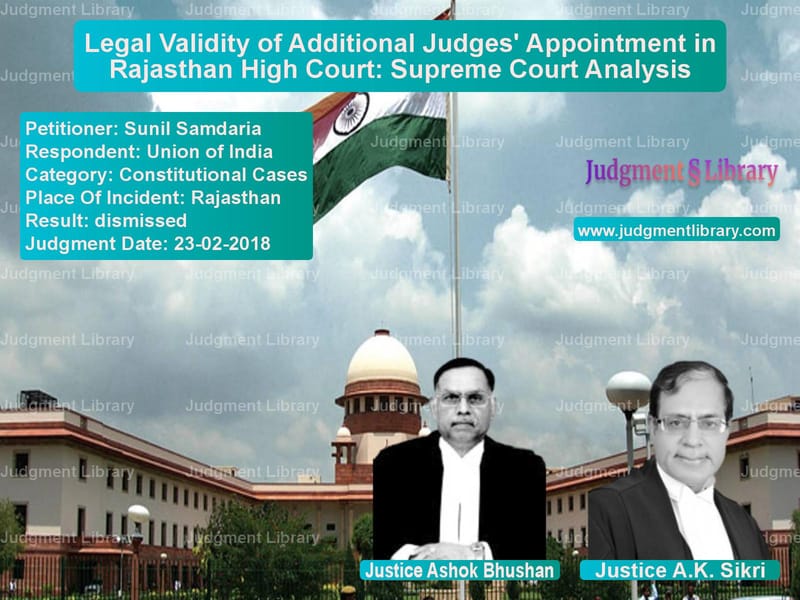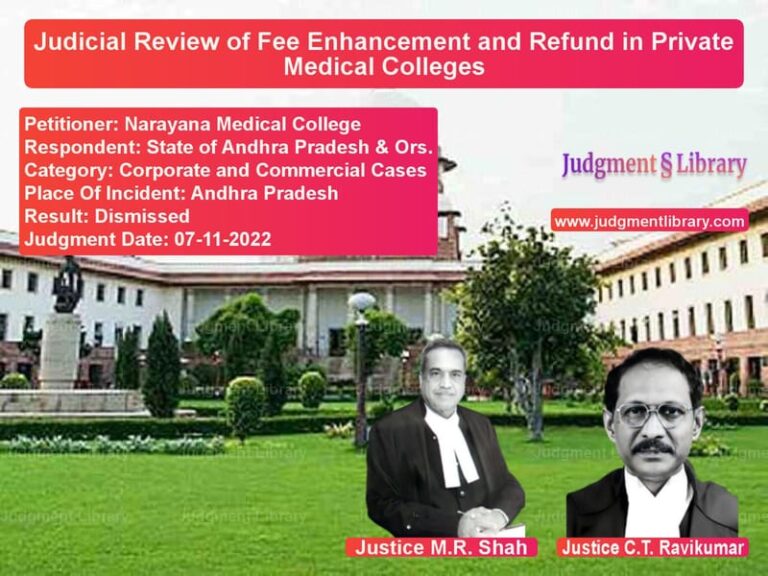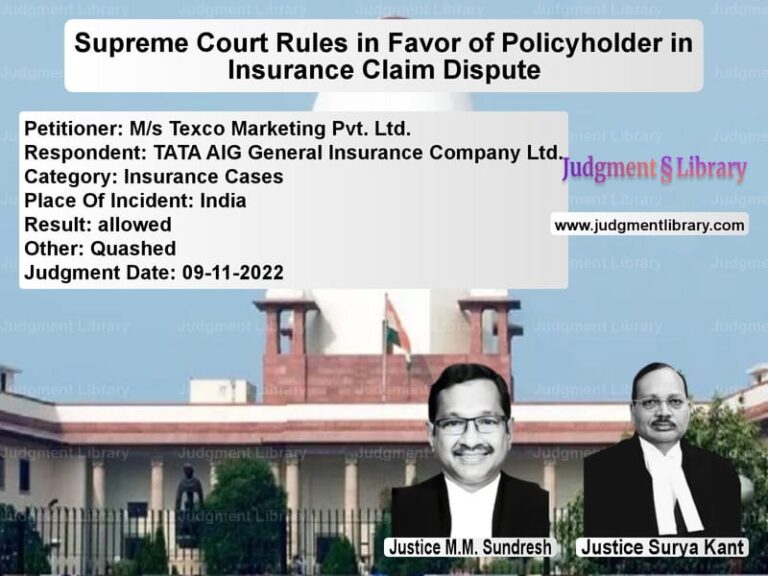Legal Validity of Additional Judges’ Appointment in Rajasthan High Court: Supreme Court Analysis
The Supreme Court of India recently delivered its judgment in the case of Sunil Samdaria v. Union of India, where the petitioner, a practicing advocate of Rajasthan High Court, challenged the appointment of two Additional Judges to the Rajasthan High Court. The petition was filed under Article 32 of the Constitution, alleging that the appointments violated constitutional provisions. The petitioner put forth two main arguments: first, that the tenure of appointment was less than two years, in contravention of Article 224 of the Constitution, and second, that the appointees were not eligible since they had retired from judicial service before their appointment.
The Supreme Court, after hearing both sides and analyzing constitutional provisions and precedents, ruled in favor of the validity of the appointments and dismissed the petition. This judgment provides important clarity on the constitutional interpretation of Article 224 and Article 217(2) regarding the eligibility and tenure of Additional Judges in High Courts.
Background of the Case
Sunil Samdaria, the petitioner, filed the writ petition challenging the notification dated 12.05.2017, through which two retired district judges were appointed as Additional Judges of the Rajasthan High Court. The petitioner argued that their appointments were unconstitutional and violative of the principles set by the Supreme Court in previous rulings.
The matter was heard by a bench comprising Justice Ashok Bhushan and Justice A.K. Sikri. The petitioner appeared in person, while the Union of India was represented by Additional Solicitor General Shri Maninder Singh.
Petitioner’s Arguments
The petitioner made two primary arguments:
- Violation of Article 224: The petitioner contended that the appointment of Additional Judges for a period of less than two years was unconstitutional. He relied on the Supreme Court’s judgment in S.P. Gupta v. Union of India (1981 Supp SCC 87), which he interpreted as mandating a minimum tenure of two years for Additional Judges. Since the two appointed judges were given terms that ended before two years, the petitioner argued that their appointments were void.
- Ineligibility of Appointed Judges: The petitioner further contended that Respondents No. 2 and 3, being retired district judges, were ineligible for appointment as Additional Judges of the High Court. He argued that Article 217(2)(a) of the Constitution requires that an appointee must be a member of the judicial service at the time of appointment. Since both respondents had retired before their appointments, they were no longer members of the judicial service, and thus, their appointments should be struck down.
Respondent’s Arguments
The Union of India, represented by Additional Solicitor General Shri Maninder Singh, countered the petitioner’s claims as follows:
- Compliance with Constitutional Provisions: It was argued that the appointments were in full compliance with Articles 217(2) and 224 of the Constitution. The respondents had held judicial office for more than ten years, making them eligible under Article 217(2)(a).
- Validity of Limited Term Appointments: The government clarified that Article 224 allows the appointment of Additional Judges for a period “not exceeding two years.” This means that two years is the upper limit but not a mandatory minimum period. Since the judges would reach the retirement age of 62 before completing two years, the appointments were valid until their age of superannuation.
- Distinguishing from S.P. Gupta Case: It was argued that the S.P. Gupta case does not mandate a fixed tenure of two years for Additional Judges but only states that the tenure should be reasonable in dealing with the backlog of cases. The respondents contended that the interpretation given by the petitioner was incorrect and misplaced.
Supreme Court’s Ruling
The Supreme Court dismissed the petition and upheld the validity of the appointments, making the following key observations:
1. Interpretation of Article 224
The Court clarified that Article 224 states that an Additional Judge may be appointed for a period “not exceeding two years.” This means that the appointment period can be up to two years but is not mandated to be exactly two years. The Court observed:
“The period of appointment of an Additional Judge under Article 224 is not necessarily for two years but for a period not exceeding two years. If the appointed judges reach the age of superannuation within this period, their tenure will naturally be shorter.”
2. Eligibility of Retired Judges
The Court examined the wording of Article 217(2)(a), which states that a person must have “held” a judicial office for at least ten years. The Court ruled that this meant past tenure in judicial service was sufficient to establish eligibility, and there was no requirement that the appointee must be holding a judicial office at the time of appointment.
“The term ‘held’ in Article 217(2)(a) signifies that a person who has previously served as a judge for at least ten years is eligible for appointment, even if he has retired by the time of appointment.”
3. Distinction from the S.P. Gupta Case
The Court held that the petitioner had misinterpreted the S.P. Gupta judgment. The ruling in that case was not a strict mandate for a minimum two-year term but rather a guideline suggesting reasonable tenure to address case backlog.
“The decision in S.P. Gupta does not lay down an inflexible rule that an Additional Judge must be appointed for two years. It only suggests that appointments should be made in a manner that helps clear judicial backlog.”
Significance of the Judgment
This ruling clarifies key aspects of judicial appointments under Articles 217 and 224 of the Constitution. The Supreme Court reaffirmed that:
- An Additional Judge’s tenure need not be exactly two years but should be reasonable in context.
- Retired judicial officers who meet the eligibility criteria under Article 217(2)(a) can be appointed as Additional Judges.
- The delay in judicial appointments must be addressed to prevent disruptions in judicial administration.
Final Observations by the Supreme Court
The Supreme Court also made observations on the delays in judicial appointments, emphasizing the need for a streamlined process. The Court urged the government and judiciary to ensure timely appointments to avoid litigation and unnecessary disputes.
“The delay in judicial appointments affects the justice delivery system. Timely appointments are necessary to maintain the efficiency and credibility of the judiciary.”
Conclusion
The Supreme Court’s dismissal of the petition in Sunil Samdaria v. Union of India reinforces the constitutional framework governing judicial appointments. By upholding the appointments, the Court has provided clarity on the eligibility criteria and tenure for Additional Judges. This ruling ensures that qualified retired judges can contribute to the judiciary while also maintaining judicial efficiency by allowing flexible appointment terms.
Petitioner Name: Sunil SamdariaRespondent Name: Union of IndiaJudgment By: Justice Ashok Bhushan, Justice A.K. SikriJudgment Date: 23-02-2018
Don’t miss out on the full details! Download the complete judgment in PDF format below and gain valuable insights instantly!
Download Judgment: Sunil Samdaria vs Union of India Supreme Court of India Judgment Dated 23-02-2018.pdf
Direct Downlaod Judgment: Direct downlaod this Judgment
See all petitions in Constitution Interpretation
See all petitions in Fundamental Rights
See all petitions in Public Interest Litigation
See all petitions in Judgment by Ashok Bhushan
See all petitions in Judgment by A.K. Sikri
See all petitions in dismissed
See all petitions in supreme court of India judgments February 2018
See all petitions in 2018 judgments
See all posts in Constitutional Cases Category
See all allowed petitions in Constitutional Cases Category
See all Dismissed petitions in Constitutional Cases Category
See all partially allowed petitions in Constitutional Cases Category







